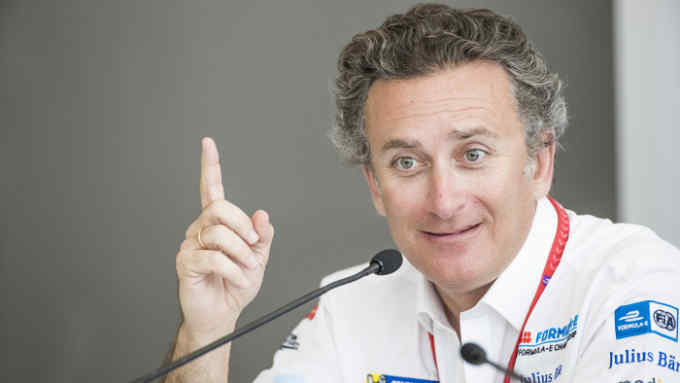Felipe Massa and Sam Bird have ‘more fun’ in Formula E than F1

Simply sign up to the Electric vehicles myFT Digest -- delivered directly to your inbox.
Felipe Massa is one of the most successful Formula One drivers of his generation. Over 15 years of driving in the series, the Brazilian totted up 11 Grand Prix wins, 16 pole positions and 41 podium finishes.
At the end of the 2017 season, the 37-year-old called time on his F1 career. Then he made an interesting move, signing a three-year deal to race in the ABB FIA Formula E championship with the Monaco-based Venturi team.
“I have always followed Formula E and thought it would take about three years to establish itself,” says Mr Massa. “And now, in years four and five, it is really developing very strongly . . . I especially like the format of race meetings, the city-centre circuits and the contact with the fans.”
While Mr Massa came to the all-electric series from the pinnacle of motorsport, British racing driver Sam Bird joined to give his driving career a second chance. “I had been let go by Mercedes [after testing as a reserve F1 driver],” he says. “I decided to give Formula E a chance when I was at a very low point.”
The fact that Lucas di Grassi, another F1 driver, had signed up for Formula E gave Mr Bird the confidence to pursue the all-electric series. “I trust him, he is a friend but also has a good business head on him,” says Mr Bird. “If he was going to put his name to this new formula, it was good enough for me.”
Both Mr Massa and Mr Bird enjoy the atmosphere of Formula E, which Mr Massa describes as “much more relaxed and friendly” compared with F1. “The drivers, though very competitive on track, are more pleasant. The whole experience is a lot more fun,” he says.
Mr Bird, who has raced for Envision Virgin Racing since 2014, agrees and adds that there is also more interaction with supporters. “Fans can mix with drivers and teams,” he says.
Podium ceremonies are a good example of this. In Formula E, these take place in the “fan zone” — an open-access area for supporters — that drivers walk through to claim their prize. Though the crowd is controlled, fans tend to get much closer to Formula E drivers compared with their F1 peers.

While F1 drivers do the all-important autograph sessions and stage appearances, they tend to be kept more separate from fans. After the race, for example, the winners are taken to a room to cool down, before they are escorted through internal corridors to the ceremony on the podium.
Friendliness among the drivers does not cross over to the track, however. “It’s very competitive: this year we have had six different winners across six races,” says Mr Massa. “This is top-level racing in a single-seater car,” adds Mr Bird.
The Brazilian’s past status and success in F1 has made competition even more fierce. “As the most famous driver in this formula, I am a target,” he says. “The younger drivers ask questions and want advice about driving, show great respect and are very nice to me. But the same drivers want to beat me. They want to be able to tell their friends they have gone past me.”
It is not just a case of coming first, either. Just as any driver competing in motorsport cannot use too much fuel, Formula E drivers have to manage their battery energy. “The goal is to go as fast as possible using the least amount of energy as possible,” says Mr Bird. “To do this, you have to hit strict energy targets throughout the race.”
Mr Massa says that managing the battery as a driver “is quite an art”. He adds: “You have to save energy whilst going as fast as possible. It’s a completely different set of challenges than in other forms of motorsport. Experience is the key: I am still learning, but the racing is great fun.”
When it comes to the future, both Mr Massa and Mr Bird are optimistic about the series. “Formula E is like an avalanche, getting bigger all the time and seemingly unstoppable,” says Mr Bird. “No one knows where it will end up: the series is just four and a half years old. We have big crowds and mainstream TV coverage . . . We race in London, Paris, New York. How many years has F1 been trying to get a race in New York?”
Mr Massa is even more confident about the longer term. “This formula has a strong future,” he says. “The world is changing and we have electric cars on the road. My son may not even know what a combustion engine was.”
What does this mean for Mr Massa’s old sport? “F1 is still very relevant and huge, no doubt. It has history and heroes,” says Mr Massa.
“But Formula E is here to stay,” he adds. “Who knows, maybe F1 and Formula E can do a deal, find a way of working together, merge.”
This is not so fanciful a thought. F1 is owned by Liberty Media, while Liberty Global has invested in Formula E. The US media billionaire John Malone is the chairman of both companies.
It may be a step too far and too early right now, but the prospect of a unified, global hybrid or electric series, where the best of both formulas join forces, might prove very attractive to the sponsors and large media platforms that Liberty wish to court.

Comments